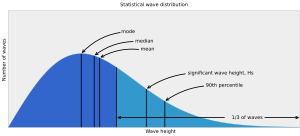Significant wave height facts for kids
The significant wave height (often called SWH or Hs) is a special way to measure how big ocean waves are. It helps us understand the overall "sea state," which includes how strong the winds are and how much swell (waves that have traveled far from where they were created) is present.
Think of it as the average height of the tallest one-third of waves you'd see in the ocean. It's a very important measurement for sailors, scientists, and anyone who needs to know about ocean conditions.
Contents
What Is Significant Wave Height?
The idea of significant wave height came from a scientist named Walter Munk during World War II. He wanted a way to describe wave heights that matched what an experienced sailor would actually see and report. Sailors naturally focus on the bigger waves, so the "highest third" idea made sense.
How We Define It
Significant wave height can be figured out in a couple of ways, but they both give very similar results.
One way is to look at a series of measured waves. You take all the wave heights, sort them from tallest to shortest, and then average the top one-third of those waves. This average is the significant wave height. This method is called H1/3.
Another way uses math based on the "energy" of the waves, which scientists call the wave spectrum. This method is often called Hm0. Both H1/3 and Hm0 are very close in value.
- The root-mean-square (RMS) wave height is another way to measure waves. It's about 1.4 times smaller than the significant wave height.
How Big Can Waves Get?
The significant wave height (Hs) helps us understand how likely it is to see very tall waves. Most waves in the ocean are actually smaller than the significant wave height. This means that seeing a wave exactly at the significant wave height isn't super common.
However, it's definitely possible to encounter waves much taller than the significant wave height! For example, if the significant wave height is 10 meters (about 33 feet):
- About 1 in 10 waves will be taller than 10.7 meters (35 feet).
- About 1 in 100 waves will be taller than 15.1 meters (49.5 feet).
- About 1 in 1,000 waves will be taller than 18.6 meters (61 feet).
This shows that you could run into a wave that's almost double the significant wave height! These extremely large waves are sometimes called rogue waves.
For example, on December 9, 2007, a record significant wave height of 17.2 meters (56.4 feet) was measured off the coast of Ireland.
Measuring Waves
Scientists use different tools to measure significant wave height.
- Most measuring devices figure out the significant wave height by looking at the wave's energy patterns.
- Satellite radar altimeters are special because they can measure significant wave height directly from space! They do this by timing how long it takes for radar signals to bounce off both the wave crests (tops) and troughs (bottoms). The highest wave ever measured by a satellite was 20.1 meters (66 feet) during a storm in the North Atlantic in 2011.
Weather Forecasts
Organizations around the world are responsible for providing ocean weather forecasts. These groups, called Regional Specialized Meteorological Centers (RSMCs), include wave height forecasts in their reports, always using the significant wave height.
In the United States, the National Weather Service (part of NOAA) is an RSMC for parts of the Atlantic and Pacific oceans. They use special computer programs called wind-wave models to help predict sea conditions. One important model they use is called WAVEWATCH III(R).
Different Wave Systems
The idea of "significant wave height" can also be used for different types of waves within the ocean. For example, you can have a significant wave height for waves caused directly by the wind (called "wind-sea") or for waves that have traveled a long distance from where they were formed (called "swell").
See also
 In Spanish: Altura de ola significante para niños
In Spanish: Altura de ola significante para niños
- Ocean Prediction Center
- Rogue wave: a wave of over twice the significant wave height
- Sea state



